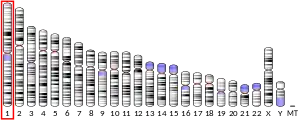Relaxin/insulin-like family peptide receptor 4
Relaxin/insulin-like family peptide receptor 4, also known as RXFP4, is a human G-protein coupled receptor.[5]
Function
GPR100 is a member of the rhodopsin family of G protein-coupled receptors (GPRs) (Fredriksson et al., 2003).[supplied by OMIM][5]
See also
References
- GRCh38: Ensembl release 89: ENSG00000173080 - Ensembl, May 2017
- GRCm38: Ensembl release 89: ENSMUSG00000049741 - Ensembl, May 2017
- "Human PubMed Reference:". National Center for Biotechnology Information, U.S. National Library of Medicine.
- "Mouse PubMed Reference:". National Center for Biotechnology Information, U.S. National Library of Medicine.
- "Entrez Gene: RXFP4 relaxin/insulin-like family peptide receptor 4".
External links
- "Relaxin Family Peptide Receptors: RXFP4". IUPHAR Database of Receptors and Ion Channels. International Union of Basic and Clinical Pharmacology.
Further reading
- Bathgate RA, Ivell R, Sanborn BM, Sherwood OD, Summers RJ (May 2005). "Receptors for relaxin family peptides". Annals of the New York Academy of Sciences. 1041: 61–76. doi:10.1196/annals.1282.010. PMID 15956688. S2CID 1185573.
- Bathgate RA, Ivell R, Sanborn BM, Sherwood OD, Summers RJ (March 2006). "International Union of Pharmacology LVII: recommendations for the nomenclature of receptors for relaxin family peptides". Pharmacological Reviews. 58 (1): 7–31. doi:10.1124/pr.58.1.9. PMID 16507880. S2CID 7466039.
- Takeda S, Kadowaki S, Haga T, Takaesu H, Mitaku S (June 2002). "Identification of G protein-coupled receptor genes from the human genome sequence". FEBS Letters. 520 (1–3): 97–101. doi:10.1016/S0014-5793(02)02775-8. PMID 12044878. S2CID 7116392.
- Liu C, Chen J, Sutton S, Roland B, Kuei C, Farmer N, Sillard R, Lovenberg TW (December 2003). "Identification of relaxin-3/INSL7 as a ligand for GPCR142". The Journal of Biological Chemistry. 278 (50): 50765–70. doi:10.1074/jbc.M308996200. PMID 14522967.
- Boels K, Schaller HC (November 2003). "Identification and characterisation of GPR100 as a novel human G-protein-coupled bradykinin receptor". British Journal of Pharmacology. 140 (5): 932–8. doi:10.1038/sj.bjp.0705521. PMC 1574110. PMID 14530218.
- Fredriksson R, Höglund PJ, Gloriam DE, Lagerström MC, Schiöth HB (November 2003). "Seven evolutionarily conserved human rhodopsin G protein-coupled receptors lacking close relatives". FEBS Letters. 554 (3): 381–8. doi:10.1016/S0014-5793(03)01196-7. PMID 14623098. S2CID 11563502.
- Liu C, Chen J, Kuei C, Sutton S, Nepomuceno D, Bonaventure P, Lovenberg TW (January 2005). "Relaxin-3/insulin-like peptide 5 chimeric peptide, a selective ligand for G protein-coupled receptor (GPCR)135 and GPCR142 over leucine-rich repeat-containing G protein-coupled receptor 7". Molecular Pharmacology. 67 (1): 231–40. doi:10.1124/mol.104.006700. PMID 15465925. S2CID 25164369.
- Liu C, Kuei C, Sutton S, Chen J, Bonaventure P, Wu J, Nepomuceno D, Kamme F, Tran DT, Zhu J, Wilkinson T, Bathgate R, Eriste E, Sillard R, Lovenberg TW (January 2005). "INSL5 is a high affinity specific agonist for GPCR142 (GPR100)". The Journal of Biological Chemistry. 280 (1): 292–300. doi:10.1074/jbc.M409916200. PMID 15525639.
This article incorporates text from the United States National Library of Medicine, which is in the public domain.
This article is issued from Wikipedia. The text is licensed under Creative Commons - Attribution - Sharealike. Additional terms may apply for the media files.



